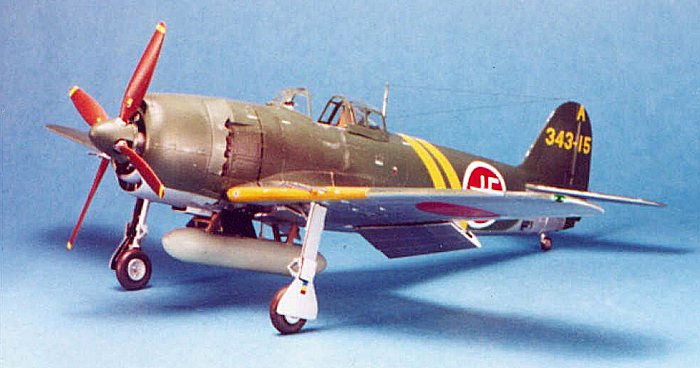
Hasegawa 1/48 N1K2-J 'Shiden-kai
|
KIT # |
9073 |
|
PRICE: |
$23.95 |
|
DECALS: |
Two Aircraft, see review |
|
REVIEW : |
|
|
NOTES: |
|

|
HISTORY |
While the Kawanishi N1K1-J "Shiden" was at the time of its introduction the outstanding fighter aircraft used by the Imperial Japanese Navy and remained a potent adversary throughout the rest of the war, the aircraft had a number of shortcomings that Kawanishi sought to rectify. Chief among these was the unreliability of the Homare 21 engine, while the wheel brakes were so bad the aircraft was often landed on grass next to a paved runway to reduce the landing roll without brakes. The result of this upgrade was the N1K2-J "Shiden-Kai", which was without a doubt the finest Japanese Navy fighter of the war; its only competitor for the title of best Japanese fighter of the war was the Nakajima Ki.84 "Hayate."
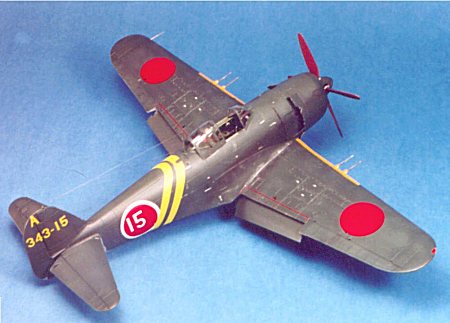 The Shiden-Kai was a
near-complete redesign of the original airframe, with the wing change from the
mid to the low position with all four 20mm cannon housed within the wing being
the most obvious visual differentiation from its predecessor. The airplane was
also simplified for ease of production, using only 43,000 parts compared with
the 66,000 of the N1K1-J. The Homare 21 engine was modified, but in the end
proved no more reliable in the N1K2-J than it had in the N1K1-J. The prototype
flew December 31, 1943, with excellent results. Full-scale production was to
begin in the summer of 1944, but - like the N1K1-J before it - the prototypes
began experiencing prolonged development troubles which resulted in production
line changes which inexorably slowed production. As the American strategic
bombing campaign came into its own in the fall of 1944, the program experienced
further delays in delivery of engines landing gear assemblies, aluminum
extrusions and steel forgings. Kawanishi produced only 60 Shiden-Kai aircraft in
1944, and only 294 in 1945 prior to the end of the war. Japanese Navy 1946
production quotas for 9, 240 Shiden-Kai fighters show how important the airplane
was.
The Shiden-Kai was a
near-complete redesign of the original airframe, with the wing change from the
mid to the low position with all four 20mm cannon housed within the wing being
the most obvious visual differentiation from its predecessor. The airplane was
also simplified for ease of production, using only 43,000 parts compared with
the 66,000 of the N1K1-J. The Homare 21 engine was modified, but in the end
proved no more reliable in the N1K2-J than it had in the N1K1-J. The prototype
flew December 31, 1943, with excellent results. Full-scale production was to
begin in the summer of 1944, but - like the N1K1-J before it - the prototypes
began experiencing prolonged development troubles which resulted in production
line changes which inexorably slowed production. As the American strategic
bombing campaign came into its own in the fall of 1944, the program experienced
further delays in delivery of engines landing gear assemblies, aluminum
extrusions and steel forgings. Kawanishi produced only 60 Shiden-Kai aircraft in
1944, and only 294 in 1945 prior to the end of the war. Japanese Navy 1946
production quotas for 9, 240 Shiden-Kai fighters show how important the airplane
was.
The N1K2-J shared with the Ki.84 the ability to be an "ace-maker," with performance such that an average pilot in a Shiden-Kai was the equal of any Allied fighter he met, including the P-51D Mustang. In June 1945, Warrant Officer Kinsuke Muto - a pilot of exceptional skill - was jumped by 12 F6F Hellcats. He succeeded in shooting down four before the others broke to escape back to their carrier and he successfully landed his damaged Shiden-Kai back at Yokosuka airfield. Although the airplane was outstanding in fighter vs. fighter combat, it was a disappointment in the one category that was really needed: high altitude interception against the B-29s. the N1K2-J suffered poor climb above 22,000 feet due to loss of engine power above that altitude.
"The Squadron of Experts":
In March 1945, Captain Minoru Genda, one of the outstanding Japanese Naval officers of the war - he was the man who planned the Pearl Harbor attack - formed the 343rd Air Group, the only IJNAF organization to be completely mounted on the N1K2-J Shiden-Kai. The unit was known as "The Squadron of Experts" because it had the highest concentration of aces of any unit in the Japanese Navy.
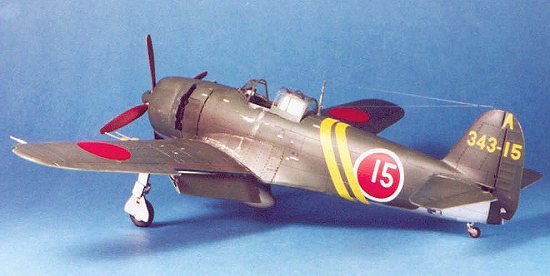 On March 19, 1945, the
group experienced their baptism of fire when Task Force 58 struck the Japanese
naval base at Kure. Genda scrambled all three squadrons of the 343rd; first
contact came when VBF-17 F6Fs from the "Bunker Hill" ran into flights
from 407th and 701st squadrons. In a vicious dogfight, six Hellcats and six
N1K2-Js went down; the battles continued, with the 343rd offering the only
defense of the base. According to the group's records for that day, the three
squadrons of the 343rd claimed 53 Hellcats and Corsairs, and four Helldivers,
for a loss of 13. Chief Petty Officer Katsue Kato - one of the greatest Japanese
aces of the war - scored nine of this total. Given that, at this stage of the
war, the American pilots did not have the level of training their predecessors
who had fought in 1942-44 had, such an outcome against pilots as experienced as
those of the 343rd, mounted in an airplane like the Shiden-Kai, is not really
that surprising. Had the IJNAF been able to re-equip with the Shiden-Kai in the
numbers planned, the air battles over Japan in 1945 might have been very
different, though the outcome of the war was no longer in doubt.
On March 19, 1945, the
group experienced their baptism of fire when Task Force 58 struck the Japanese
naval base at Kure. Genda scrambled all three squadrons of the 343rd; first
contact came when VBF-17 F6Fs from the "Bunker Hill" ran into flights
from 407th and 701st squadrons. In a vicious dogfight, six Hellcats and six
N1K2-Js went down; the battles continued, with the 343rd offering the only
defense of the base. According to the group's records for that day, the three
squadrons of the 343rd claimed 53 Hellcats and Corsairs, and four Helldivers,
for a loss of 13. Chief Petty Officer Katsue Kato - one of the greatest Japanese
aces of the war - scored nine of this total. Given that, at this stage of the
war, the American pilots did not have the level of training their predecessors
who had fought in 1942-44 had, such an outcome against pilots as experienced as
those of the 343rd, mounted in an airplane like the Shiden-Kai, is not really
that surprising. Had the IJNAF been able to re-equip with the Shiden-Kai in the
numbers planned, the air battles over Japan in 1945 might have been very
different, though the outcome of the war was no longer in doubt.
One of the outstanding pilots of the 343rd was Lt. Naoshi Kanno, the top-scoring Naval Academy graduate of the war. Kanno first saw combat in the N1K1-J Shiden with the original 343rd Air Group during the invasion of the Marianas in June 1944. Flying from the island of Yap, he shot down several B-24 Liberators using the head-on attack method. He was credited with 30 kills total in the summer of 1944. When the group was reorganized by Genda, Kanno was given command of the 301st Squadron. In the battle of March 19, the 301st initially took on Corsairs of VMF-123; Kanno was among the 13 shot down when he was hit by a Corsair from VBF-10, though he parachuted safely. Under Kanno's command, the 301st suffered the highest casualties of any unit in the 343rd, though it also had the highest score. Kanno himself was credited with 13 more victories while flying the N1K2-J, before being killed attacking B-24s over Yaku Island on August 1, 1945.
|
THE KIT |
Hasegawa has basically "owned" the N1K2-J for 30 years, since they introduced a 1/72 kit of the airplane in the early 1970s that advanced the state of the art with razor-sharp trailing edges and engraved panel detail. This kit is still in production and still the best of this airplane in 1/72 scale. In 1981, a 1/48 version was released that again was as far in advance of the competition in this scale as the earlier kit had been ahead of anything else in 11/72 when it was released. In fact, the 1981 release is so good that - when Hasegawa announced a new kit of this airplane - many modelers said "why?" Admittedly the model has raised panel lines rather than the de rigueur engraved lines, but it still makes up into a very acceptable model.
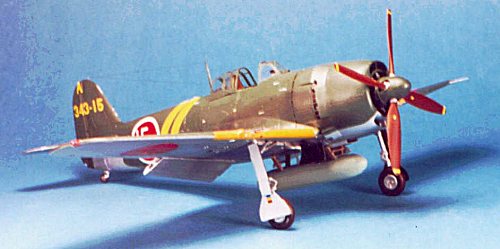 Well. The new Hasegawa
offering is as far in advance of other 1/48 models recently released as the
earlier ones were in their day. Last year I said that the Hasegawa Ki.84 Hayate
was the best kit they had released. This N1K2-J Shiden-Kai even surpasses
that excellent model. On the basis of this quality of kit-making, I personally
cannot wait to see how they top themselves with the F4U-5 Corsair - due out in
the shops over the next few weeks.
Well. The new Hasegawa
offering is as far in advance of other 1/48 models recently released as the
earlier ones were in their day. Last year I said that the Hasegawa Ki.84 Hayate
was the best kit they had released. This N1K2-J Shiden-Kai even surpasses
that excellent model. On the basis of this quality of kit-making, I personally
cannot wait to see how they top themselves with the F4U-5 Corsair - due out in
the shops over the next few weeks.
The kit is the N1K2-J, the early-production Shiden-Kai with the larger vertical fin and rudder. The model comes on three sprues of medium-grey plastic, with crisp molding, and a clear 3-part canopy that is almost as thin as a vacuform canopy. Decals are for two aircraft of the 343rd Air Corps, including the aircraft flown by Lt. Kanno on March 19, 1945.
|
CONSTRUCTION |
What can I say? This is one of the best-engineered kits yet released by Hasegawa, who have obviously been paying close attention to how Tamiya creates models that are highly detailed yet easy to build. All the parts fit, and overall creating the model was an easy weekend project. I spent more time painting the details in the cockpit and painting the model overall than I did in assembly of the kit. It would take a modeler who was either illiterate, blind, or willfully opposed to following the instructions to create a bad model from this kit.
I had the good fortune to have Aero Detail No. 26, "The N1K2-J Shiden-Kai," as my reference material. Anyone familiar with the Aero Detail series knows they are the Rolls-Royce Silver Cloud of reference books. This volume has numerous clear, well-lit, color photos of every part of the N1K2-Ja Shiden-Kai restored by the Champlin Fighter Museum for the National Air and Space Museum, plus detailed drawings of most major components. Following these photos, I had no problem creating a very good-looking cockpit. This cockpit needs no resin replacement, being well-detailed in its own right and setting a new standard in the line of what Hasegawa has done with their Jill and Hayate kits previously.
|
PAINT & DECALS |
Once the model was assembled, I first painted the model overall with flat black along the panel lines for "pre-shading. I then painted the leading edges of the wing with Gunze-Sanyo "Orange Yellow." When this was dry I masked it off for the "combat ID stripes, then gave the model an overall coat of SnJ aluminum paint. I followed this up by painting the drop thank, and the fabric-covered ailerons and elevators with Tamiya "IJN Grey." I used a mixture of Gunze-Sanyo H-302 Green FS 34102 and "IJN Green" to get a color that was an exact match to the color used on the Champlin Museum restoration, which is down in "Kawanishi Green." When I was finished shooting the upper color, I put in a bit of white to lighten it, then went over various panels to create a faded effect. The prop blades were painted with Tamiya "Red Brown." Using Scotch tape, I then lifted some of the upper camouflage paint to show chipping in the areas of the wing walks and where th cowling would have been worked on. I then shot the model with a coat of Future overall.
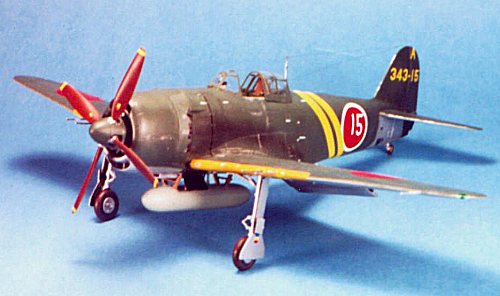 Decals:
Decals:
I used the kit decals to do Kanno's airplane with the "15" in the fuselage Hinomaru. When I applied the yellow squadron leader's stripes, I found they were translucent enough to be able to see the Hinomaru beneath, so I trimmed the Hinomaru with an X-acto blade and pulled that section out from under the stripe decal. Other than this minor difficulty, the decals went on well and looked right when they had set up. I washed the model, then shot another coat of Future over it.
Final Finish:
I airbrushed Tamiya "Smoke" over various areas of the lower natural metal finish, then shot the entire model with "Flat Future," my mixture of Future and Tamiya "Flat Base." I shot several coats to get the upper finish very flat, then shot the exhaust stains with Tamiya "smoke" mixed with the "Flat Future." Since "Smoke" is glossy, the result was a semi-gloss that simulates the oil-base of the exhaust stain and makes these stand out from the surrounding surface.
I then attached the landing gear, the prop, and the cockpit canopy. I finished off by making antenna wires from nylon repair thread.
|
CONCLUSIONS |
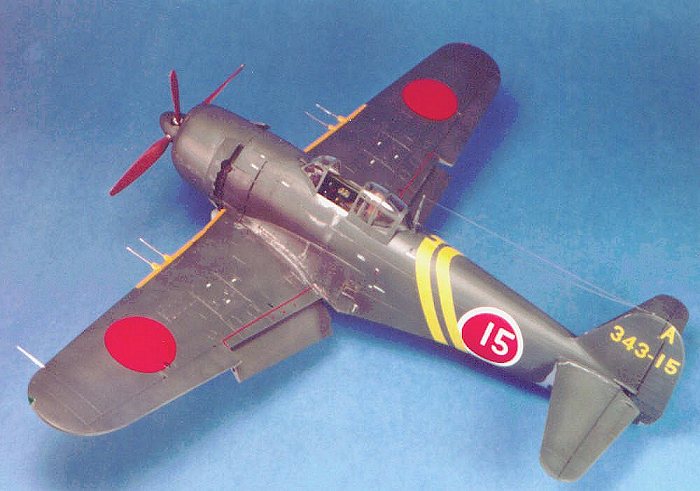
If this was a movie review, I would give this model a five-star rating. It is one of the best examples of the kit makers art currently available, a model that can do for its modelers what its 1:1 original did for its pilots: make the average guy look good, and the good look great. The model provides excellent value for the money and results in something you'll be proud to have on your shelf.
Copyright ModelingMadness.com. All rights reserved. No reproduction in part or in whole without express permission from the editor.
If you would like your product reviewed fairly and fairly quickly, please contact the editor or see other details in the Note to Contributors.
Back to Reviews Page 2016